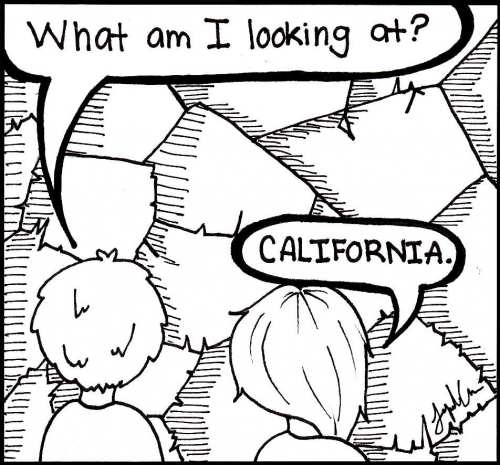Californians’ Drought Dilemma

JANET GUAN
Copy Editor
Using the sprinklers in daylight is not acceptable for the next few months. This past July, California implemented mandatory water conservation rules to combat the ongoing drought. These restrictions will stay in place for 270 days or less if repealed.
California’s most recent drought period was from 2008 to 2011. When it first began, the “slight” dry spell was expected to end in 2010. However, that was not the case. The drought ended in 2011, a year later, when it shifted east towards Texas. California was declared in a drought again in 2012. According to Time Magazine, even when water conservation was encouraged in January 2014, Californians used more water in May 2014 than the past three year average for that month. Since voluntary water conservation produced no effect, restrictions became mandatory. The decision to “wait it out” for the 2008 drought produced slower results, so why were laws not implemented as soon as California was declared in a drought?
Droughts do not disappear by themselves, and with most of California naturally dry, it is susceptible to use more water for maintaining plant life, for consumption, and for aesthetic use. However, most of California does not look like the dry environment it is supposed to be. Californians expect the grass to be green, for produce to be top-notch, and for fountains to be running. All of these expectations require water that California doesn’t have. Nevertheless, they continue to be met with outside water sources. The Colorado River, which starts in Wyoming and Colorado mountains, provides some of the water Southern California uses. Yet, even the Colorado River is facing a drought, according to the New York Times.
Many have become habituated to using large amounts of water when not necessary, mainly because Californians do not see the drought in plain sight. Parks are still appealing with green grass. Trees and bushes still look well. However, the entire state of California is considered to be in a drought, with 80 percent of the state in the extreme level, according to Time Magazine. California’s product prices help to tell a different story than what the public eye sees. In 2012 to 2013, the California Department of Food and Agriculture (CDFA) cited California as the producer for most of the U.S.’s milk and indicated the increase of milk’s price. Since cow feed takes water to produce, the rising cost can also be pointed to lower water availability.
With the drought affecting food sources that provide for all of the U.S., it is imperative to get out of the drought as fast as possible. With neighboring states running low on water as well, importing water to support California will be costly. Since some states rely on California for food, lower food production means higher food prices in those respective states. Also, with the drop in crop production, California’s amount of exported produce will lower as well, resulting in lower income from international customers. Overall, the drought will negatively impact California’s economic status.
The restrictions will bring improvement in California’s water level. However, leaving the majority of the restrictions can provide a permanent solution to the recurring problem. It does not make sense to return to water-wasting habits, only to necessitate the implementation of restrictions again. Californians need to understand that not all water being used is from California, and should only be used when necessary or efficiently. To stop wasting water, even the most minute actions need to be considered, such as fixing water-wasting leaks in a timely matter. However, all of the laws prevent Californians from further aggravating the drought.